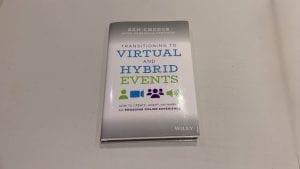
Overview
The book is fairly short at 178 pages with additional information, such as a glossary and index. It is divided into eleven chapters and a conclusion. It begins by describing what virtual and hybrid events can look like. Then it explains how to plan and prepare for them, both in terms of the process and the people. There is also a chapter on how to monetize your event and market it.
The subtitle of the book is “How to create, adapt, and market an engaging online experience”. In fact, it does more than that. Chodor draws the author into his world by first explaining what a virtual and hybrid event is. This allows the reader to draw the similarities between the physical and virtual. The author carefully explains that they are not the same though, something that many companies struggled with at the start of the pandemic.
The rest of the book provides a roadmap for running your virtual event. It also raises, and addresses, a vast array considerations and questions for the reader.
What was it like
Initially, the authors were careful to stress that there is no set way to run a virtual event. While it didn’t spell this out, one suspects that if the author were asked how one should run an event, he would answer “it depends”. That’s sensible advice as the answer will depend on industry vertical, objectives and other factors.
Chodor explains the many ways in which virtual events can happen and the benefits that can accrue from running them. He writes about the different responsibilities for the planning team members and also how important it is to separate physical and virtual event planning teams. This is of critical importance as companies move to hybrid events.
He also gives some examples of successful events. In a recent interview with Mark Woodhams of BlackLine, their new CRO revealed how successful the “In the Black” virtual event was. Proving, not just from the authors’ experience but also from others, that organisations can have even greater success in a virtual world.
The second half of the book provides a seemingly endless list of questions that the reader will need to ask people in their organisation. This is the meat of the book. While it does not give the reader a clear roadmap, it certainly gives them food, if not a feast, for thought. If they can answer these questions, they can either engage with a virtual event planning expert or look to build something themselves once they put the answers together.
What I didn’t like about his book
The book provides a comprehensive but light overview of pretty much everything about marketing, planning and running virtual events. However, there were a couple of areas that were glossed over. For example, engagement with media, influencers and analysts could do with some expansion. There could also have been more detail about the technology available. Though to be fair, that would probably date the book incredibly quickly considering how rapidly such technology is evolving at the moment.
At times it almost felt there were too many questions or bullet points with not enough structure around them as a whole. This also made it harder to read at times. On reflection, that might not be a bad thing as it shows that event planners need to create an event suitable for their audience rather than a prescribed path. However, it was a stark contrast to a book by Patrick Lencione.
The only thing that jarred was the case study example given in the marketing section. The case study of ABC Concert seemed to focus on a live, physical event. It would have been far more powerful to have included a virtual event. No one needs hotel accommodation at a virtual event!
Analysis
This is a must-have book in 2020/2021. While not necessarily the easiest book to read in terms of flow, it does provide an incredible amount of information and pointers on running virtual and hybrid events. Virtual events will continue through 2021 and, hopefully, physical will begin to return.
Would I read this again?
If I were planning or involved in planning a virtual event, I definitely would read this book again. While it is the first book I have read on event planning to date, it seems comprehensive and provides the reader with the questions they need to ask. One might ask why it doesn’t say how to do more things. This would have made the book far too long and would probably be an impossible task.
Enterprise Times was sent a review copy of this book. Published by Wiley, it is available from Amazon Aus/UK/US.

























